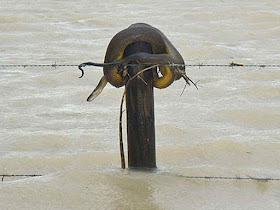New research suggests that global warming is causing the cycle of evaporation and rainfall over the oceans to intensify more than scientists had expected, an ominous finding that may indicate a higher potential for extreme weather in coming decades.
By measuring changes in salinity on the ocean’s surface, the researchers inferred that the water cycle had accelerated by about 4 percent over the last half century. That is twice the figure generated from computerized analyses of the climate.
If the estimate holds up, it implies that the water cycle could quicken by as much as 20 percent later in this century as the planet warms, potentially leading to more droughts and floods.
The study "Ocean Salinities Reveal Strong Global Water Cycle Intensifiction," by Paul Durack et al. provides another piece of independent evidence that global warming is a serious problem facing humanity. Durak is a researcher at the Lawrence Livermore National Laboratory in California and the lead author of the paper published last week in the journal Science. Read the abstract of the paper at this link: OCEAN SALINITIES INTENSIFICATION.The researchers’ analysis found that over the half century that began in 1950, salty areas of the ocean became saltier, while fresh areas became fresher. That change was attributed to stronger patterns of evaporation and precipitation over the ocean.
The new paper is not the first to find an intensification of the water cycle, nor even the first to calculate that it might be fairly large. But the paper appears to provide more scientific evidence than any paper to date in support of a high estimate.
The paper is the latest installment in a long-running effort by scientists to solve one of the most vexing puzzles about global warming.
While basic physics suggests that warming must accelerate the cycle of evaporation and rainfall, it has been difficult to get a handle on how much acceleration has already occurred, and thus to project the changes that are likely to result from continued planetary warming.
The fundamental problem is that measurements of evaporation and precipitation over the ocean — which covers 71% of the earth’s surface, holds 97% of its water and is where most evaporation and precipitation occurs — are spotty at best. To overcome that, scientists are trying to use the changing saltiness of the ocean’s surface as a kind of rain gauge.
That works because, as rain falls on a patch of the ocean, it freshens the surface water. Conversely, in a region where evaporation exceeds rainfall, the surface becomes saltier.
The variations in salinity are large enough that they can be detected from space, and NASA recently sent up a new satellite, Aquarius, for that purpose. But it will take years to obtain results, and scientists like Dr. Durack are trying to get a jump on the problem by using older observations, including salinity measurements taken by ships as well as recent measurements from an army of robotic floats launched in an international program called Argo.
The study suggests that a global warming of about 1° F over the past half century has been enough to intensify the water cycle by about 4 percent. That led Dr. Durack to project a possible intensification of about 20% as the planet warms by several degrees in the coming century.
That would be approximately twice the amplification shown by the computer programs used to project the climate, according to Dr. Durack’s calculations. Dr. Durack’s paper is the latest of several indications that warming estimates may be conservative.
 |
| A stranded snake in last year's Queensland, Australia flood. Read about the end -- at least for now -- of Australia's BIG DRY at Phillip's Natural World 2.0 |
The new paper confirms a long-expected pattern for the ocean that also seems to apply over land: Areas that receive a lot of rainfall in today’s climate are expected to become wetter, whereas dry areas are expected to become drier.
In the climate of the future, scientists fear, a large acceleration of the water cycle could feed greater weather extremes. Perhaps the greatest risk from global warming, they say, is that important agricultural areas could dry out, hurting the food supply, as other regions get more torrential rains and floods.





